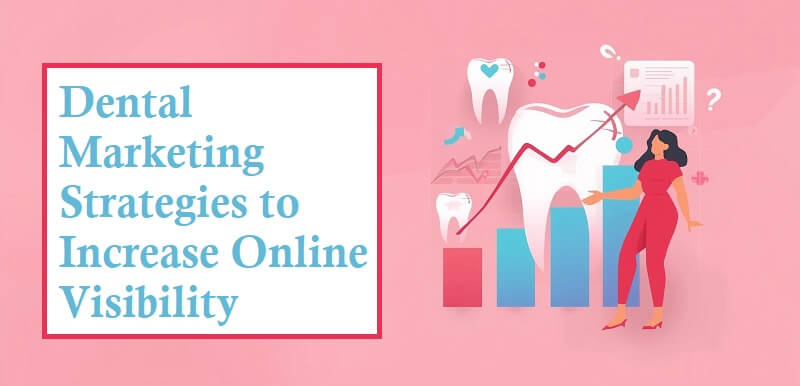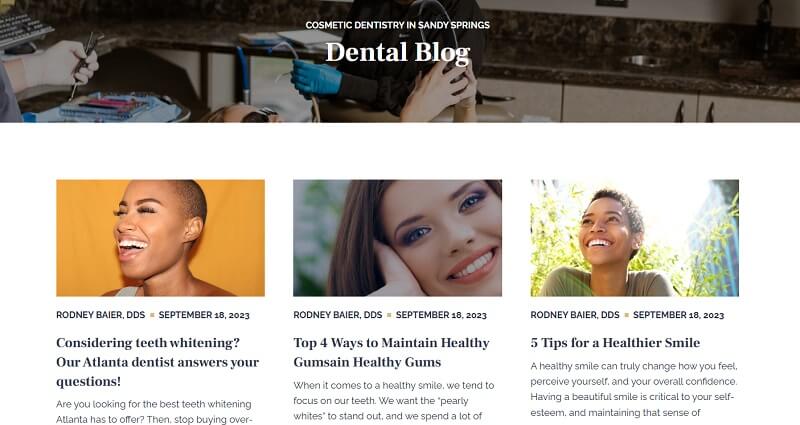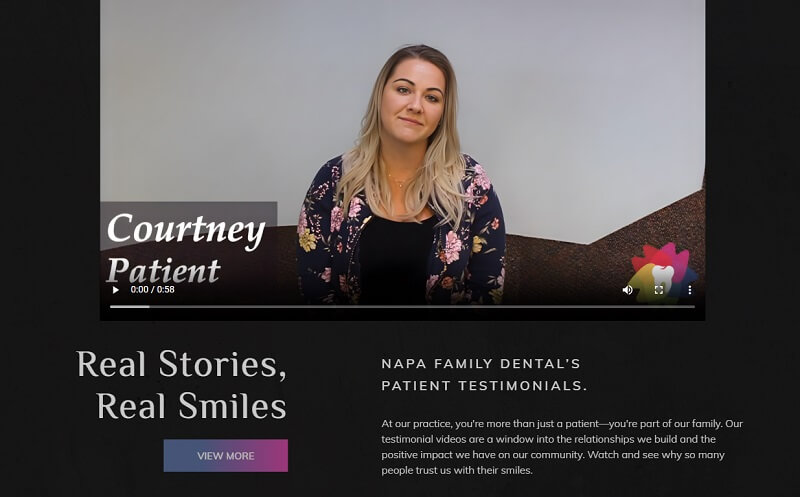
6 Dental Marketing Strategies to Increase Online Visibility
in Digital Marketing on November 6, 2025Running a successful dental practice requires more than clinical expertise — it also depends on implementing effective Dental Marketing Strategies. You need a steady stream of new patients to keep your chairs filled and your schedule full. However, with an increasing number of people searching for healthcare providers online, having a strong digital presence is no longer optional — it’s essential.
According to recent surveys, over 77% of patients use search engines before booking a healthcare appointment. If your practice isn’t appearing in those search results, you’re missing out on potential patients who are actively looking for dental services in your area.
Justin Morgan, known in the industry as the Dentist Marketing Guy, has spent years running a dentist marketing agency, helping dental practices improve their online visibility and attract more patients. His approach combines proven digital marketing tactics with strategies tailored explicitly to dental practices.
In this guide, we’ll explore six key dental marketing strategies that can help increase your online visibility, attract more patients, and grow your practice. Whether you’re just starting to build your online presence or looking to refine your existing efforts, these actionable tips will help you stand out in a competitive market.
1. Optimize Your Google Business Profile

Your Google Business Profile (formerly Google My Business) is often the first impression potential patients have of your practice. When someone searches for “dentist near me” or “family dentist in [city],” your profile appears in the local search results and on Google Maps.
A complete and optimized profile can significantly increase your visibility. Start by ensuring all your basic information is accurate: practice name, address, phone number, website URL, and hours of operation. Consistency is key here—ensure this information aligns with what’s on your website and other online directories.
But don’t stop at the basics. Add high-quality photos of your office, team, and treatment rooms. Practices with photos receive 42% more requests for directions and 35% more clicks to their websites than those without. These visuals help potential patients feel more comfortable before they even walk through your door.
Regularly post updates to your profile. Share office news, dental health tips, special promotions, or before-and-after photos (with patient permission, of course). These posts appear in search results, keeping your profile active and engaging.
Perhaps most importantly, actively manage your reviews. Respond to both positive and negative feedback promptly and professionally. Reviews influence not only patient decisions but also your ranking in local search results. Encourage satisfied patients to leave reviews by making the process easy—send follow-up emails with direct links or display QR codes in your office. You can take this a step further with a dynamic QR code generator, which lets you change the link later on so the same code can switch from reviews to referral campaigns or seasonal offers.
2. Invest in Local SEO
Local search engine optimization helps your practice appear when people in your area search for dental services. Unlike general SEO, local SEO focuses on geographic-specific searches, enabling you to compete for patients in your immediate community.
Begin by claiming and optimising your listings on major online directories, such as Yelp, Healthgrades, and Zocdoc. Ensure your NAP (Name, Address, Phone number) information is identical across all platforms. Search engines use this consistency to verify the legitimacy and location of your practice.
Incorporate location-based keywords throughout your website. Instead of just targeting “cosmetic dentistry,” use phrases like “cosmetic dentistry in [city name]” or “teeth whitening near [neighborhood].” Include these keywords naturally in your page titles, headings, meta descriptions, and content.
Create location-specific content on your website. Write blog posts about community events, local dental health initiatives, or dental concerns common in your area. This content signals to search engines that you’re relevant to local searches.
Build local citations and backlinks. Get listed in your local chamber of commerce, sponsor community events, or partner with other local businesses. Each mention of your practice online strengthens your local SEO.
Don’t overlook technical SEO elements. Ensure your website loads quickly, works well on mobile devices, and includes schema markup for local businesses. These technical factors influence how search engines crawl and rank your site.
3. Create Educational Content That Answers Patient Questions
Content marketing positions your practice as a trusted resource while improving your search engine rankings. When you consistently create valuable content, you attract potential patients who are researching dental topics online.
Start by identifying the questions your patients ask most frequently. What procedures do they want to understand better? What dental health concerns keep them up at night? Use these questions as the foundation for your content strategy.
Write blog posts that address these topics in clear, accessible language. Break down complex procedures into understandable terms. Explain what patients can expect during and after treatment. Discuss costs, insurance coverage, and recovery times. The more comprehensive and helpful your content, the more likely people will trust your expertise.
Video content performs exceptionally well for dental practices. Create short videos showing your office tour, introducing your team, or explaining common procedures. Videos build trust by putting a face to your practice and help anxious patients feel more comfortable.
Develop downloadable resources, such as dental care guides, pre- and post-operative instructions, or checklists for choosing a dentist. These resources provide value while capturing contact information for your email list.
Maintain a consistent publishing schedule. Regular content updates signal to search engines that your website is active and relevant. Aim for at least one new piece of content per week, whether it’s a blog post, video, or social media update.
Remember to optimize each piece of content for search engines. Include relevant keywords, write compelling meta descriptions, use descriptive image alt text, and link to related pages on your website. Quality content that’s properly optimized can attract organic traffic for years.

4. Leverage Social Media to Build Relationships
Social media platforms offer dental practices a direct channel to connect with current and potential patients. While social media may not immediately boost your search rankings, it can increase brand awareness, drive website traffic, and foster trust within your community.
Choose platforms where your target patients spend time. Facebook remains a popular platform across various demographics and is well-suited for dental practices. Instagram appeals to younger audiences and provides an excellent platform for visual content. LinkedIn can help you network with other healthcare professionals and establish yourself as a thought leader.
Post consistently but prioritize quality over quantity. Share a mix of content types: educational posts about dental health, behind-the-scenes glimpses of your practice, patient testimonials (with permission), team spotlights, and community involvement. This variety keeps your feed interesting and engaging.
Use social media to showcase your practice’s personality. Let your team’s warmth and professionalism shine through. Share celebrations, achievements, and the everyday moments that make your practice special. Authenticity resonates more than polished corporate content.
Engage with your followers actively. Respond to comments and messages promptly. Answer questions about dental health (while being careful not to provide specific medical advice online). Thank patients who leave positive feedback. This engagement fosters relationships and demonstrates your care for the community.
Consider running targeted social media advertising campaigns. Platforms like Facebook and Instagram offer sophisticated targeting options based on location, age, interests, and behaviors. Even a modest advertising budget can increase your reach and attract new patients in your area.
Don’t forget to include social sharing buttons on your website and blog posts. When patients find your content valuable, make it easy for them to share it with their networks.
5. Implement an Email Marketing Strategy
Email marketing remains one of the most effective and cost-efficient marketing channels available. For dental practices, email helps maintain relationships with existing patients while nurturing potential patients through the decision-making process.
Start by building your email list strategically. Collect email addresses from new patients during their first visit. Add signup forms to your website, offering valuable content such as dental care tips or special promotions. Never purchase email lists—focus on growing an engaged audience that’s genuinely interested in your practice.
Segment your email list to send more relevant messages. Create different segments for new patients, existing patients, inactive patients, and prospects. Tailor your content to each group’s specific needs and stage in the patient journey.
Send appointment reminders and follow-ups. These service-oriented emails reduce no-shows and keep your schedule full. Include helpful information about preparing for appointments or post-treatment care instructions.
Share your blog content and educational resources via email. Position your practice as a valuable source of dental health information. This keeps your practice top of mind when recipients need dental services.
Promote special offers and new services through email campaigns. Whether you’re offering teeth whitening promotions or introducing a new provider, email provides a direct way to inform your patient base.
Include clear calls-to-action in every email. Whether you want recipients to book an appointment, read a blog post, or follow you on social media, make the next step obvious and easy.
Monitor your email metrics to refine your strategy by tracking open rates, click-through rates, and conversions. Test different subject lines, send times, and content types to see what resonates with your audience.
6. Encourage and Showcase Patient Reviews

Online reviews have become the digital equivalent of word-of-mouth referrals. Potential patients trust the experiences of others, and positive reviews can be the deciding factor when choosing a dental practice.
Studies show that 84% of people trust online reviews as much as personal recommendations. Furthermore, practices with higher ratings and more reviews tend to rank better in local search results. Reviews influence both your reputation and your visibility.
Make asking for reviews part of your patient experience. Train your staff to request reviews from satisfied patients at the end of appointments. Send follow-up emails a few days after treatment, asking patients to share their experience, and include a referral link to make it easy for them to recommend your practice to others.
Make leaving a review as easy as possible. Provide direct links to your Google Business Profile, Yelp, or Facebook page. Some practices use QR codes displayed at the front desk that patients can quickly scan with their phones.
Respond to all reviews, both positive and negative. Thank patients who leave positive feedback. For negative reviews, respond professionally and compassionately. Acknowledge the concern, apologize if necessary, and offer to resolve the issue privately. Your response demonstrates to potential patients that you value their satisfaction.
Highlight your best reviews on your website and social media platforms. Create graphics featuring testimonials or dedicate a page on your website to patient stories. Video testimonials are particularly powerful—ask satisfied patients if they’d be willing to share their experience on camera.
Never purchase fake reviews or incentivize positive reviews in a manner that violates platform guidelines. Authenticity matters, and platforms are increasingly sophisticated at detecting fraudulent reviews. Focus on genuinely great patient experiences, and the reviews will follow naturally.
How to Measure Your Marketing Success
Implementing these strategies is just the beginning. You need to track your results to understand what’s working and where to adjust your efforts.
Utilize Google Analytics to track your website’s traffic. Track key metrics such as total visitors, traffic sources, bounce rate, and average pages per session. Pay special attention to how people find your site—are they coming from search engines, social media, or direct links?
Monitor your search rankings for key terms. While exact rankings fluctuate, tracking your position for important keywords over time helps you gauge your SEO progress.
Track phone calls and appointment bookings. Utilize call tracking software to determine which marketing channels generate the most phone inquiries. Many practice management systems can help you identify the source of new patient appointments.
Review your Google Business Profile insights regularly. See how many people viewed your profile, requested directions, visited your website, or called your practice. These metrics help you understand your local search performance.
Calculate your return on investment (ROI) for paid marketing efforts. If you’re running social media ads or pay-per-click campaigns, track your cost per lead and cost per patient acquisition.
Set specific, measurable goals for each marketing channel. Rather than vague objectives like “increase website traffic,” aim for concrete targets, such as “increase organic website traffic by 20% over the next quarter” or “generate 10 new patient appointments per month from Google Business Profile.”
Take Action to Grow Your Practice
Building a strong online presence takes time and consistent effort, but the results are worth it. Each strategy outlined here works together to increase your visibility, establish your expertise, and attract more patients to your practice.
Start by assessing your current online presence. Google your practice name and see what appears. Search for dental services in your area and note where your practice ranks. Review your website, social media profiles, and online listings with fresh eyes.
Choose one or two strategies to focus on first. If your Google Business Profile needs work, start there. If you’ve been meaning to start blogging, commit to publishing one post per week. Small, consistent actions compound over time.
Consider partnering with a dental marketing specialist for additional support. While you can implement many of these strategies yourself, marketing professionals bring expertise and free up your time to focus on patient care.
The dental market is competitive, but with the right marketing strategies, your practice can stand out. Focus on providing value, building trust, and making it easy for potential patients to find and choose your practice. Your online visibility—and your appointment book—will thank you.








